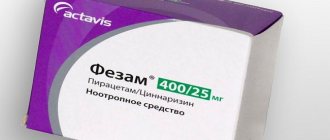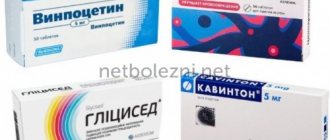Symptomatic treatment
The goal of symptomatic therapy is to eliminate or alleviate existing neurological symptoms. Symptomatic therapy has no effect on the course of MS itself, but can improve the patient’s quality of life. For this purpose, drugs of various groups are used. Often, the same remedy simultaneously eliminates several manifestations of multiple sclerosis.
Synthetic analogues of GABA
Gamma-aminobutyric acid is one of the so-called. inhibitory mediators in the central nervous system. Damage to brain structures in multiple sclerosis is accompanied by the elimination of inhibitory impulses with the development of muscle spasms and spastic pain. Such symptoms are eliminated with the help of Baclofen. This synthetic analogue of GABA restores inhibitory impulses and inhibits spasm. Baclofen relaxes not only skeletal but also smooth muscles. Therefore, it can be used for spastic constipation and difficulty emptying the bladder.
Benzodiazepines
Benzodiazepine derivatives (Diazepam, Clonazepam) are similar in properties to GABA. They enhance the effect of Baclofen and also have tranquilizer properties. Therefore, they are used to eliminate anxiety and fear in patients with multiple sclerosis. In addition, benzodiazepines have analgesic properties - they can eliminate pain.
Anticholinergics
These drugs normalize muscle tone by influencing central and peripheral cholinergic receptors. "Mydocalm", "Hyoscyamine", "Oxybutynin" are used to relieve spasms of skeletal muscles, smooth muscles of the intestines and bladder.
Antiepileptic drugs
They can also be useful for multiple sclerosis. “Carbamazepine”, “Phenytoin” prevent the development of seizures, normalize sensitivity, and are effective for neuritis accompanied by pain, impaired swallowing and speech.
Tricyclic antidepressants
Eliminates feelings of depression and fatigue, improves mood and performance. These drugs also normalize muscle tone and eliminate pain.
Vitamins
The importance of these biologically active substances in multiple sclerosis is difficult to overestimate. B vitamins normalize sensitivity and movement, ascorbic acid improves immunity, vitamin E strengthens blood vessels, and vitamin D prevents the development of osteoporosis, a frequent companion of multiple sclerosis. All drugs for the symptomatic treatment of multiple sclerosis are used only as prescribed by a doctor and under his supervision.
Pediatric multiple sclerosis: what's new?
The report given at the First Pan-Slavic Congress of Child Neurologists on September 6, 2012 (Bled, Slovenia) is used as the basis for the article. This report opened the scientific program of the congress.
Definition of Pediatric Multiple Sclerosis
Multiple sclerosis (MS) is a chronic, autoimmune, etiologically multifactorial progressive disease of the central nervous system and/or peripheral nervous system, in which the formation of plaques in the cerebral and/or spinal structures leads to polysymptomatic exacerbations, alternating with periods of remission.
Pediatric MS includes variants with multiple episodes of demyelination separated in time and space (as in adult patients), but without any age restrictions on diagnosis. The diagnosis of “pediatric MS” is legitimately applicable to patients under the age of 10 years [1, 2].
Damage to the peripheral nervous system in multiple sclerosis
For many years, damage to the peripheral nervous system has been considered as an argument against the presence of MS. Damage to peripheral nerves has traditionally been attributed to toxic factors, physical exposure, etc., but these factors are unlikely to explain the lesions present in MS. Thus, radiculopathies can be induced by demyelinated plaques localized in the inner part of the nerve roots. Therefore, MS should be considered as a demyelinating disease of the central nervous system associated with pathology of the peripheral nervous system (radiculopathies, mono- and polyneuropathies). This circumstance, in particular, is indicated by Couratier P. et al. (2004) [3].
The pathogenetic mechanisms of MS and peripheral nerve damage are partly explained by antigen specificity and the presence of diffusible factors between the myelin of the central nervous system and the peripheral nervous system, as well as the molecular plasticity of myelinated fibers [3].
What is multiple sclerosis?
In accordance with modern concepts, MS can be considered from various positions as 1) a demyelinating disease; 2) autoimmune disease; 3) state of genetic predisposition; 4) a combination of demyelination, inflammation and axonal loss; 5) age-independent disease, 6) nutrition-dependent disease (partially).
Demyelination. This is the main symptom of MS in all age groups. The destruction of the myelin sheath (demyelination) in MS is local but multifocal. There are three main theories explaining demyelination in MS: 1) congenital or acquired pathology of the myelin sheath, 2) disorders of the myelin sheath due to circulation disorders and thrombosis of small veins of the central nervous system, 3) inflammation of the myelin sheath.
Autoimmunity. Immune reactions typical of the pathogenesis of MS are synonymous with autoimmunity. The combination of two main pathological mechanisms (demyelination and inflammation) turns MS into an autoimmune disease.
Genetic predisposition. MS only affects susceptible individuals. In many European populations, MS is most often associated with the DR2 haplotype of the HLA class II histocompatibility system.
Combination of lesions in MS. Neuroimaging and histological analysis confirm the combination of demyelination, inflammation and axonal loss in MS.
Independence of age. Up to 10% of cases of MS onset occur before the age of 18 years. The earliest onset of MS is described by Shaw CM and Alvord CM Jr. (1987) in a 10-month-old infant [4].
Nutritional dependence. It has been reliably established that there is a significant relationship between the consumption of animal fats (intensive meat eating) and milk/dairy products. Vitamin D deficiency (a micronutrient) also reflects one of the important aspects of the etiology of MS.
Multiple sclerosis and vaccination
Currently, immunoprophylaxis (vaccination) is not considered contraindicated for children and adolescents with MS [5]. Recent studies confirm that preventive vaccination does not increase the risk of exacerbation of disease symptoms in MS, and is not a causative agent of the disease [6]. Moreover, tetanus vaccination reduces the risk of demyelinating diseases of the central nervous system [7].
Multiple sclerosis and neurogenetics
Below are the MS susceptibility genes identified in various countries and ethnic groups (regions of positive association): chromosome 1 (p25 - Canada, p21 - Great Britain, q11-24 - Scandinavia, q31 - Canada, q42-44 - Italy, Australia); chromosome 2 (p23 - USA, p21 - Canada, p13 - Australia, q24–33 - Finland, Scandinavia, Canada, q36 - Italy); chromosome 3 (p26 - Scandinavia, p25 - Canada, p14 - Canada, q21–24 - USA, Canada, Scandinavia, Australia, Finland, q21 - Turkey, q26 - Canada); chromosome 4 (p16 - Canada, q12 - Scandinavia, Finland, q24 - Australia, q26-28 - Australia, Canada, q31-35 - Australia, USA); chromosome 5 (p14-tel - Canada, p12-14 - Finland, p15 - Turkey, q11-13 - Australia, UK, q15 - Turkey, q13-23 - USA, Canada, Italy, q33 - Italy); chromosome 6 (p25 - Scandinavia, Italy, p21 - Canada, Scandinavia, Finland, UK, USA, GMA, q14 - Canada, q21 - Scandinavia, q22 - Italy, q26 - Australia, q27 - Australia, USA), chromosome 7 (p21 — Canada, p15 — Great Britain, p14 — Canada, q11 — USA, q21–22 — USA, Canada, q32–35 — Australia, USA); chromosome 8 (p23–21 - Australia); chromosome 9 (q21 - Australia, p24–22 - USA, q34 - Scandinavia, USA); chromosome 10 (p15 - Scandinavia, p12-13 - Scandinavia, q21-22 - USA, Finland, q24 - Sardinia, q26 - Canada); chromosome 11 (p15 - Scandinavia, Sardinia, USA, q25 - Finland, q22 - Canada); chromosome 12 (p13 - UK, q21 - Scandinavia, q23 - USA, q24 - USA); chromosome 13 (q31–32 – Australia, q33–34 – USA); chromosome 14 (q32 - Canada); chromosome 15 (q21 - Italy, Canada); chromosome 16 (p13 - Scandinavia, Australia, USA, p11 - Australia, q23–24 - Australia, q12 - Canada); chromosome 17 (p13 - Australia, q21 - GMA, q22–24 - Finland, UK, q25 - Scandinavia); chromosome 18 (p11 - Australia, Finland, Canada, USA, q21 - Canada); chromosome 19 (p13 - Türkiye, q13 - GMA); chromosome 20 (p12 - Australia); chromosome 22 (q12–13 - Scandinavia, UK, q13 - GMA); chromosome X (p21 - Australia, Canada, p11 - Australia, Canada, p22 - Scandinavia, Canada, Turkey, q23–28 - Australia, q26 - Canada). The acronym GMA stands for Global Meta-Analysis.
In the Russian Federation, two genetic loci DRB1 from the HLA class II system on chromosome 6 were studied in children with MS; frequent detection of the DR2 haplotype (15) confirms the involvement of genetic factors in the formation of increased susceptibility to the development of MS in patients under the age of 16 years [8].
The International Multiple Sclerosis Genetics Consortium reported in 2010 that among seven single nucleotide polymorphisms presumably associated with MS, the RGS1 allele, which is common to MS and celiac disease, was found [9]. The described single nucleotide polymorphisms were identified during a meta-analysis.
RGS1 is one of the newest MS susceptibility loci. In this regard, the question again arises about the role of gluten intolerance in the formation of MS. This issue continues to be extremely controversial.
Vitamin D and the formation of multiple sclerosis
Thus, it has been demonstrated that high levels of vitamin D in the blood reduce the risk of MS in Caucasians. In particular, according to Munger KL et al. (2004), an increase in the level of 25-hydroxyvitamin D in the blood by 50 nmol/l reduces the likelihood of MS by approximately 40% [10].
According to Goodin DS (2009), vitamin D deficiency is no less important a factor in the “causal cascade of MS” than infection with the Epstein–Barr virus [11].
There is growing evidence for the role of vitamin D deficiency in various autoimmune diseases, including MS. Vitamin D is a powerful regulatory factor that suppresses immunopathological reactions (excessive activity of CD3+ T cells leading to damage to the myelin sheath of neurons).
Neuroimmunology of Multiple Sclerosis
When examining indicators of cellular immunity in patients with pediatric MS, it is advisable to expand the standard panel of monoclonal antibodies (MAbs) by including the following three markers: 1) CD25 (low-affinity interleukin-2 receptor chain); 2) CD95 (Fas ligand); 3) CD122 (high-affinity interleukin-2 receptor chain) [12, 13].
Matrix metalloproteinases in multiple sclerosis
Matrix metalloproteinases (MMPs) are proteases that have the ability to degrade extracellular matrix components. It is believed that MMPs are responsible for the entry of inflammatory mononuclear cells into the central nervous system, and also partially determine the processes of myelin destruction and disruption of the integrity of the blood-brain barrier (BBB) in MS.
Apparently, increased activity of MMP-9 in relation to tissue inhibitor of MMP type 1 (TIMP-1) is important in the formation of new lesions (plaques) in MS. In this regard, it is assumed that serum levels of MMP-9 and TIMP-1 are surrogate markers of disease activity in relapsing-remitting MS. In turn, serum levels of MMP-3 also correlate with the activity of relapsing-remitting MS [14, 15].
Diagnosis of multiple sclerosis in the 21st century
Since the beginning of the 2000s. The diagnosis of MS was established in accordance with the criteria proposed by McDonald WI et al. (2001) [16]. Subsequently, these criteria were revised twice by Polman CH et al. (2005, 2010) [17, 18].
We present the latest criteria after the last revision in the table.
Neurodietology and multiple sclerosis
The main goal of diet therapy for MS is to correct metabolic syndrome and provide the patient with balanced nutritional components of the diet. It is recommended to limit sugar (sucrose), animal proteins and saturated fats.
It is proposed to enrich the diet of patients with MS with polyunsaturated fatty acids (PUFAs) - linoleic, gamma-linolenic. The use of a number of other biologically active food additives (phospholipids - lecithin, sphingomyelin, antioxidants coenzyme Q10) is effective.
Of the monovitamins in MS, vitamins D (calciferol), A (retinol), E (tocopherol), K (menadione), folic acid, B6 (pyridoxine), B12 (cyanocobalamin) and C (ascorbic acid) are especially important, and of the minerals substances - Ca (calcium), Mg (magnesium), K (potassium), P (phosphorus), Mn (manganese), I (iodine) and Se (selenium) [19].
As suggested by Balch PA (2006), edible medicinal plants and preparations based on them can be used for MS; in particular, these include Medicago sativa L., Arctium tomentosum, Araxacum officinale, Echinacea purpurea, Hydrastis Canadensis, pau d'arco, Trifolium pretense, Hypericum perforatum, Sarsaparilla, Achillea millefolium L., etc. [20].
Adequate fluid intake is recommended for all MS patients.
A number of diets previously used in the treatment of MS are currently not considered effective. These include, in particular, hypoallergenic diets, low-energy diets (various variations), diets with limited pectin/fructose, as well as diets enriched with cerebrosides (extracts of cerebral lipids from cows).
Agliadin (gluten-free) diets, on the contrary, are again gaining importance, which is partly due to the above data on the genetic similarity of MS and celiac disease. Currently, positive experience with strict gluten-free diets has been presented by researchers from around the world. In particular, this is reported in the works of Hernandez-Lahoz C. et al. (2009) and Leong E.M. et al. (2009) [21, 22].
Vitamin D in the prevention and treatment of multiple sclerosis
Antenatal/postnatal prevention of MS is possible through vitamin D supplementation (in order to increase the level of 23-hydroxyvitamin D in the blood serum) [23].
According to Smolders J. et al. (2008), and Solomon AJ et al. (2010), vitamin D can be used as an immunomodulator in the treatment of MS; In this case, the recommended doses of calciferol are 1000–10000 IU/day [24, 25].
New Multiple Sclerosis Therapies (Good News and Bad News)
In recent years, the following types of pharmacological agents used in the treatment of MS have been registered in the Russian Federation: 1) natalizumab (Tysabri) - a drug based on mAbs to adhesion molecules (alpha integrins); 2) cladribine (Movectro); 3) fingolimod (Gilenya); 4) two types of interferon beta-1b (Extavia, Ronbetal) for subcutaneous administration; 5) high-dose human immunoglobulins (10%) for intravenous administration (Gamunex, Octagam) [26]. There has been a routinization of the practice of using methylprednisolone in pulse therapy mode (instead of oral prednisolone).
Mitoxantrone and cyclophosphamide are considered second-line treatments for MS. This circumstance is indicated by Yeh EA et al. (2009), Makhani N. et al. (2009), as well as Castillo-Trivino T. et al. (2011) [27–29].
A high-dose drug of interferon beta-1a (Rebif 44) is routinely used in the treatment of MS in patients under 18 years of age.
The development of new methods of treating MS continues, many of which are still experimental. In Israel, a preclinical study of the use of fullerenes (carbon-containing antioxidants) in MS has been completed. Two drugs based on mAbs are used in the treatment of MS: alemtuzumab (mAb CD52) for secondary progressive disease, rituximab (mAb CD20) for primary progressive and remitting disease. The immunomodulatory drug laquinimod (a quinolone-3-carboxamide derivative) is a new oral treatment currently undergoing phase 3 studies for the treatment of relapsing-remitting MS.
Unfortunately, glatiramer acetate (Copaxone-Teva) is still not approved for the treatment of MS in patients under 18 years of age. A similar situation occurred with natalizumab (Tysabri). The drug Betaferon (interferon beta-1b for subcutaneous administration), well known to neurologists, is no longer available in the Russian Federation; it is proposed to replace it with the new drugs Extavia and Ronbetal. Instead of the drug Avonex (interferon beta-1a for intramuscular administration), its analogue, SinnoVex, is increasingly being offered. Rebif 22 (low-dose interferon beta-1a for subcutaneous administration) is gradually being replaced by Genfaxon.
The effectiveness of exchange plasmapheresis in the treatment of exacerbations of MS, as well as the use of human immunoglobulins for intravenous administration in the preventive therapy of MS remains unconfirmed from the standpoint of evidence-based medicine, although many years of international practice indicate the opposite. The drug Naltrexone remains unavailable in the Russian Federation (no registration as of 2012).
***
In conclusion, let us quote the authors of the book “Demyelinating diseases of the central nervous system in childhood” D. Chabas and EL Waubant (2011): “Pediatric MS appears to be more than an adult disease in a child’s body” [30].
Literature
- Krupp LB et al. Consensus definitions proposed for pediatric multiple sclerosis and related disorders // Neurology. 2007. V. 68. Suppl. 2. S. 7–12.
- Belman AL et al. Challenges in the classification of pediatric multiple sclerosis and future directions // Neurology. 2007. V. 68. Suppl. 2. S. 70–74.
- Couratier P. et al. Sclerose en plaques et atteinte du systeme nerveux peripherique // Rev. Neurol (Paris). 2004. V. 160. P. 1159–1163.
- Shaw CM, Alvord EC Jr. Multiple sclerosis beginning in infancy // J. Child Neurol. 1987. V. 2. P. 252–6.
- Sievers EJ, Heyneman CA Relationship between vaccinations and multiple sclerosis // Ann. Pharmacother. 2002. V. 36. P. 160–162.
- Rutschmann OT et al. Immunization and MS: a summary of published evidence and recommendations // Neurology. 2002. V. 59. S. 1837–1843.
- Hernan MA et al. Tetanus vaccination and risk of multiple sclerosis: a systematic review // Neurology. 2006. V. 67. P. 212–215.
- Bykova O. V. Features of multiple sclerosis in children. Author's abstract. dis. ... Ph.D. M., 2002. 24 p.
- International Multiple Sclerosis Genetics Consortium. IL12 A, MPHOSPH9/CDK2P1 and RGS1 are novel multiple sclerosis susceptibility loci//Genes Immunol. 2010. V. 11. P. 397–405.
- Munger KL et al. Serum 25-hydroxyvitamin D levels and risk of multiple sclerosis // JAMA. 2006. V. 296. P. 2832–2838.
- Goodin DS The causal cascade to multiple sclerosis: a model for MS pathogenesis // PLoS One. 2009. V. 4. P. 1–12.
- Vysotskaya L. M. Features of immunological and neurophysiological parameters in children with multiple sclerosis. Author's abstract. dis. ... Ph.D. M. 2007. 26 p.
- Vysotskaya DS et al. Immunocompetent cells in blood of non-exacerbated pediatric patients with remitting-relapsing multiple sclerosis // Mult. Scler. 2006. V. 12. S. 163–164.
- Zahednasab H. et al. Controversial role of MMP-9 gene in MS disease // J. Neuroimmunol. 2011. V. 230. P. 191.
- Bernal F. et al. Regulation of matrix metalloproteinases and their inhibitors by interferon-beta: a longitudinal study in MS patients // Mult Scler. 2009. V. 15. S. 721–727.
- McDonald WI et al. Recommended diagnostic criteria for multiple sclerosis: Guidelines from the International Panel on the Diagnosis of Multiple Sclerosis // Ann. Neurol. 2001. V. 50. P. 121–127.
- Polman CH et al. Diagnostic criteria for multiple sclerosis: 2005 revisions to the “McDonald Criteria” // Ann. Neurol. 2005. V. 58. P. 840–86.
- Polman CH et al. Diagnostic criteria for multiple sclerosis: 2010 revisions to the McDonald criteria // Ann. Neurol. 2011. V. 69. P. 292–302.
- Studenikin V.M. et al. Multiple sclerosis in children: the role of diet // Issues. children's Dietol. 2008. T. 6. No. 6. P. 23–28.
- Balch PA Multiple sclerosis. In: Prescription for nutritional healing. A practical A-to-Z reference to drug-free remedies using vitamins, minerals, herbs & food supplements (Balch PA). 4 th ed. New York. Avery. 2006. P. 579–583.
- Hernandez-Lahoz C. et al. Sustained clinical remission in a patient with remittent-recurrent multiple sclerosis and celiac disease gluten-free diet for 6 years // Neurologia. 2009. V. 24. P. 213–215.
- Leong EM et al. Complementary and alternative medicines and dietary interventions in multiple sclerosis: what is being used in South Australia and why? //Complement. Ther. Med. 2009. V. 17. P. 216–223.
- Chaudhuri A. Why should we offer routine vitamin D supplementation in pregnancy and childhood to prevent multiple sclerosis // Med. Hypotheses. 2005. V. 64. P. 608–618.
- Smolders J. et al. Vitamin D as immune modulator in multiple sclerosis, a review //J. Neuroimmunol. 2008. V. 194. P. 7–17.
- Solomon AJ, Whitham RH Multiple sclerosis and vitamin D: a review and recommendations // Curr. Neurol. Neurosci. Rep. 2010. V. 10. P. 389–396.
- Federal guidelines for the use of drugs (formulary system). Vol. XIII. M.: “Echo.” 2012.
- Yeh EA, Weinstock-Guttman B. Moving on to second-line therapies in pediatric MS: immunosuppression with cyclophosphamide // Neurology. 2009. V. 72. S. 2064–2065.
- Makhani N., Gorman MP, Branson HM et al. Cyclophosphamide therapy in pediatric multiple sclerosis // Neurology. 2009. V. 72. S. 2076–2082.
- Castillo-Trivino T., Mowry E.M., Gajofatto A. et al. Switching multiple sclerosis with breakthrough disease to second-line therapy // PLoS One. 2011. V. 6, e16664.
- Demyelinating Disorders of the Central Nervous System in Childhood/Chabas D., Waubant EL (eds). Cambridge-New York. Cambridge University Press. 2011. 278 p.
V. M. Studenikin, Doctor of Medical Sciences, Professor L. A. Pak, Candidate of Medical Sciences V. I. Shelkovsky, Candidate of Medical Sciences L. M. Kuzenkova, Doctor of Medical Sciences, Professor S. Sh. Tursunkhuzhaeva S. R. Gutnov N. N. Shatilova
FSBI NTsZD RAMS, Moscow
Contact information for authors for correspondence
Treatment of exacerbations
During exacerbations, therapy is carried out using potent anti-inflammatory drugs and corticosteroid hormones. The regimens and doses of administration of these drugs are individually determined by the doctor depending on the patient’s condition. Along with corticosteroids, during an exacerbation, drugs that improve the functions of nervous tissue (so-called neuroprotectors), drugs that strengthen the vascular wall, and drugs that improve the rheological properties of the blood are usually prescribed. In the absence of contraindications, physical therapy and physiotherapeutic procedures are indicated.
Pathogenetic treatment
The goal of pathogenetic treatment of MS is to quickly relieve symptoms caused by exacerbations, as well as to prevent exacerbations and increase the period of remission. In addition, one should strive to change the course of the disease and slow its progression. Medicines used to treat MS can be divided into two groups. The first group is drugs that are used during periods of exacerbation. The second group is drugs that change the course of the disease by suppressing the pathologically active immune system. These include immunomodulators, immunosuppressants, cytostatics and monoclonal antibodies. Of course, the most effective type of treatment for multiple sclerosis would be etiological, aimed at eliminating the cause. But since the etiology of the disease is still poorly understood, treatment begins with influencing the pathogenesis, the mechanism of development of the disease.
Pathogenetic treatment is aimed at:
- preventing axonal demyelination;
- acceleration of remyelination;
- immunosuppression - a decrease in the pathological activity of the immune system;
- immunomodulation – change, modulation of the immune response;
- inhibition of local inflammatory and autoimmune processes;
- strengthening, reducing the permeability of the vascular wall and the BBB (blood-brain barrier).
With properly selected pathogenetic treatment, recovery processes begin to prevail over the processes of damage to the axons of the myelin sheath of nerve fibers. As a result, the severity of exacerbations is reduced, and remissions, on the contrary, are lengthened. In this case, the transition of a relapsing course into a secondary progressive course with disability occurs as late as possible or does not occur at all.
Causes and mechanism of development of multiple sclerosis
The causes of the development of multiple sclerosis remain unclear. The most substantiated theory is considered to be a combination of genetic predisposition and the influence of external factors.
Among external factors, the most important ones are:
- frequency of past infections (measles, retroviruses, Epstein-Barr virus, herpes viruses, mycoplasmas, streptococci, fungi);
- psycho-emotional stress;
- dietary habits (excessive amounts of fats and proteins of animal origin in the diet), as well as insufficient consumption of a number of vitamins (D, B12);
- contact with toxic substances (arsenic, lead);
- smoking and alcohol abuse;
- the ecological situation in the place of residence, environmental factors, as well as the composition of water and soil (lack of microelements in it).
Multiple sclerosis is an autoimmune disease. Due to genetic predisposition and exposure to external factors, the immune system malfunctions. The body begins to produce antibodies that penetrate the blood-brain barrier and connect with its own cells of the nervous tissue. As a result, immune cells perceive some of their structures (for example, the myelin sheath) as foreign and destroy them. Over time, nerve fibers undergo significant destruction. Connective tissue grows in place of destroyed structures.
If the myelin sheath can be restored to some extent, then the process of destruction of the nerve fiber itself is irreversible. While the myelin is not completely destroyed and is able to partially recover, the nerve fiber can perform its function, and the appearance and disappearance of clinical symptoms is associated with this. When the nerve fiber is destroyed, the symptoms persist forever.
Drugs
Glucocorticoids
These are synthetic analogues of adrenal hormones - Prednisolone, Methylprednisolone, Dexamethasone. These drugs for multiple sclerosis block certain biologically active substances of the cytokine class and reduce the production of T-lymphocytes. Thus, glucocorticoids inhibit inflammatory and autoimmune processes. In addition, these drugs reduce the permeability of vascular walls and the BBB. Glucocorticoids for multiple sclerosis are used in pulse therapy mode - in large doses over short periods of time.
ACTH
Adrenocorticotropic hormone is secreted by the anterior pituitary gland and stimulates the production of its own glucocorticoids by the adrenal cortex. Thus, the effect of ACTH and its synthetic analogues (Synacten, Tetracosactide) is similar to the drug of the previous group, but has less risk of side effects (ulceration, hypercortisolism). Although in this case, disturbances in water-salt metabolism and increased blood pressure are possible.
Synthetic beta interferons
(“Avonex”, “Rebif”, “Betaferon”) have an immunomodulatory effect, inhibit autoimmune processes, reduce the activity of T-lymphocytes, and prevent the penetration of cytokines through the BBB. In addition, beta interferons are effective in the initial stages of viral infections, one of the causes of multiple sclerosis.
Copaxone
This drug has immunomodulatory properties and is specially designed for the treatment of multiple sclerosis. It is a sequence of amino acids glutamine, lysine, alanine, tyrosine. Its chemical structure is similar to myelin.
Angioprotectors and antiplatelet agents
These drugs (“Curantil”, “Pentoxifylline”) prevent red blood cells from sticking together, improve blood flow and strengthen the vascular wall.
Proteolytic enzyme inhibitors
When administered intravenously, Contrikal and Gordox inhibit enzymes of the protease class, which destroy protein structures and participate in inflammatory processes. Plasmapheresis, a method of hardware extracorporeal (outside the body) blood purification, gives good results. During plasmapheresis, antigenic complexes, biologically active substances that trigger autoimmune processes, are removed along with plasma. Not so long ago, the drug Anti-LINGO-1 was developed in the USA, which accelerates remyelination. Now this drug is in the clinical trial phase, but perhaps it will still say a new word in the treatment of multiple sclerosis.









